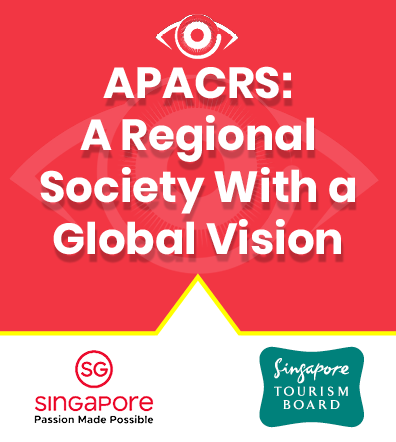Eyeworld Weekly Update |
Volume 19, Number 11 |
21 April 2014 |
- FDA issues update on phenylephrine
- J&J Vision Care soliciting research proposals
- PanOptica raises US$45M to develop topical anti-VEGF
- OWL announces annual award recipients
- Orbis heads to China
- South African program aims to reduce visual impairment by 90%
- Neurotech names CEO
FDA issues update on phenylephrine
The U.S. Food and Drug Administration has reported Alcon (Fort Worth, Texas, U.S.) and Akorn (Lake Forest, Ill., U.S.) will discontinue their unapproved phenylephrine hydrochloride ophthalmic solutions, effective 1 April 2014 and 30 June 2014, respectively. The solutions are a 2.5%, 15 mL and a 10%, 5 mL version. An approved product is distributed by Bausch + Lomb (Bridgewater, NJ, U.S.), the FDA said.J&J Vision Care soliciting research proposals
Johnson & Johnson Vision Care (Jacksonville, Fla., U.S.) is accepting research proposals related to meibography and tear film stability with contact lens wear, the company announced. Specific areas of interest include the following topics:- Correlating clinical findings (i.e., lid wiper epitheliopathy, subjective symptoms, physiology) to meibomian gland image analysis and tear film stability
- Categorizing magnitude of meibomian gland changes to contact lens type or length of wear
PanOptica raises US$45M to develop topical anti-VEGF
PanOptica (Bernardsville, NJ, U.S.) has raised up to US$45 million to fund PAN-90806, a pharmacologically unique small molecule selective inhibitor of vascular endothelial growth factor signaling being investigated as a topical treatment for neovascular age-related macular degeneration (AMD), the company said.The compound is currently in a phase 1, 2-month, open label study in approximately 30 patients at 15 to 20 clinical sites around the United States. The trial is designed to assess the safety and tolerability of topical ocular PAN-90806 at three dosage strengths in patients with active, subfoveal choroidal neovascularization associated with neovascular AMD. PanOptica expects data readout by the end of 2014.
OWL announces annual award recipients
The Ophthalmic Women Leaders have named the 2014 annual awards recipients, who will be honored at the "OWL Monday" Reception and Program during the 2014 ASCRS•ASOA Symposium & Congress. The recipients are:- 2014 Visionary Woman Award: Jane E. Rady (divisional vice president of business development, Abbott Medical Optics)
- 2014 Catalyst Award: Georgette Pascale (president/CEO, Pascale Communications)
- 2014 Rising Star Award: Tamara Bogetti, MBA (publisher, Bryn Mawr Communications)
Orbis heads to China
The Orbis Flying Eye Hospital (FEH, New York, NY, U.S.) is headed to China to provide “intense training in the areas of cataract, glaucoma, medical and surgical retina,” FEH said in a news release. To address the growing need for pediatric eyecare in the country and in support of the long-term Orbis pediatric project in the region, the FEH program will also offer intense subspecialty training in pediatric strabismus.The Jinan program is the 39th visit for the FEH to China. The FEH program is supported by Alcon (Fort Worth, Texas, U.S.).
South African program aims to reduce visual impairment by 90%
VSP Global (Rancho Cordova, Calif., U.S.) has created the “We See” Child Eye Health Project, including the opening of an eye health clinic at the Soweto Nike Football Centre in South Africa, the group announced. Over the next 3 years, the “We See” Child Eye Health Project, in collaboration with implementing partner Brien Holden Vision Institute, will provide approximately 30,000 children with free eyecare and eyewear, with the goal of reducing the percentage of school children in the Soweto area with uncorrected visual impairment by 90%.In South Africa, there are fewer than 300 optometrists available in the public sector for a population of 41 million, and 60% of children are said to need glasses but only 20% of those receive them.
Neurotech names CEO
Neurotech Pharmaceuticals (Cumberland, RI, U.S.) has named Quinton Oswald as chief executive officer. Neurotech is using its patented core technology platform (encapsulated cell technology) to develop treatments for neovascular age-related macular degeneration and for the treatment of macular telangiectasia.Mr. Oswald was previously CEO of SARcode Bioscience until that company’s acquisition by Shire in 2013.
RESEARCH BRIEFS
- Therapeutic penetrating keratoplasty continues to be an effective method in the treatment process of serious perforated and non-perforated corneal infectious and non-infectious diseases resistant to medical and other surgical interventions, according to Z. Yalniz-Akkaya and colleagues. They retrospectively evaluated the records of 24 eyes of 24 patients (17 female and 7 male) treated with therapeutic penetrating keratoplasty between 2002 and 2010, dividing the patients into the infectious keratitis group and non-infectious keratitis group. Therapeutic success was achieved and eyes were preserved in 23 patients and one patient required evisceration for recurrent fungal infection. At the end of the follow-up period, 92.9% (n=13) and 77.8% (n=7) of grafts remained clear in the infectious and non-infectious groups, respectively (P=0.538). Visual acuity improved at least one Snellen line in 23 patients. The study is published online ahead of print in International Ophthalmology.
- Selective laser trabeculoplasty (SLT) is a safe and effective option for the treatment of patients with silicone oil-induced secondary glaucoma, according to a study. M. Zhang and colleagues evaluated 42 patients (42 eyes) with silicone oil-induced secondary glaucoma, and SLT was performed with 360 degrees of the trabecular meshwork. The mean intraocular pressure (IOP) decreased from 23.1±1.9 mmHg before treatment to 18.4±3.7 mmHg after treatment (P<0.05). Mean number of anti-glaucoma medications used for IOP control also decreased from 2.17±1.21 to 1.25±0.89 (P<0.05). The success rate was 60.7% (17 eyes) and 57.1% (eight eyes) for phakic and aphakic eyes, respectively (P>0.05). The study is published online ahead of print in Graefe’s Archives for Clinical and Experimental Ophthalmology.
- IOL explantation combined with pars plana vitrectomy (PPV) is effective in managing recurrent postoperative fungal endophthalmitis, according to a report from northern India. In this retrospective, single institution, interventional case series, A. Vinkar and colleagues evaluated six patients with microbiologically proven recurrent postoperative fungal endophthalmitis refractory to conventional management. The final recurrence was managed with IOL explantation and re-PPV. Of the six cases, five were culture positive and one was smear positive for yeast. All recurred (mean recurrences, 4) despite a mean of 2.17 PPVs and intravitreal amphotericin B. No recurrences were observed after IOL explantation with re-PPV (median follow-up, 37 months). Pre-study defined criteria for successful “anatomical” and “functional” outcomes were achieved in 83.3% and 50%, respectively. The study is published in the Indian Journal of Ophthalmology.
- Rayner (Hove, UK) launched the RaySert Plus, an injector designed for “safe and effective implantations through a 2.2 mm wound assisted mini-incision.” It is approved for the delivery of the C-flex aspheric and Superflex aspheric range of IOLs, the company said.
 Licensed Publications |
Licensed through ASCRS American Society of Cataract and Refractive Surgery, 4000 Legato Road, Suite 700, Fairfax, VA 22033-4003, USA.
All rights reserved. The ideas and opinions expressed in EyeWorld Asia-Pacific Weekly News do not necessarily reflect those of the ASCRS�ASOA or APACRS. Mention of products or services does not constitute an endorsement by the ASCRS�ASOA or APACRS. Copyright 2008, EyeWorld News Service, a division of ASCRS Media. |



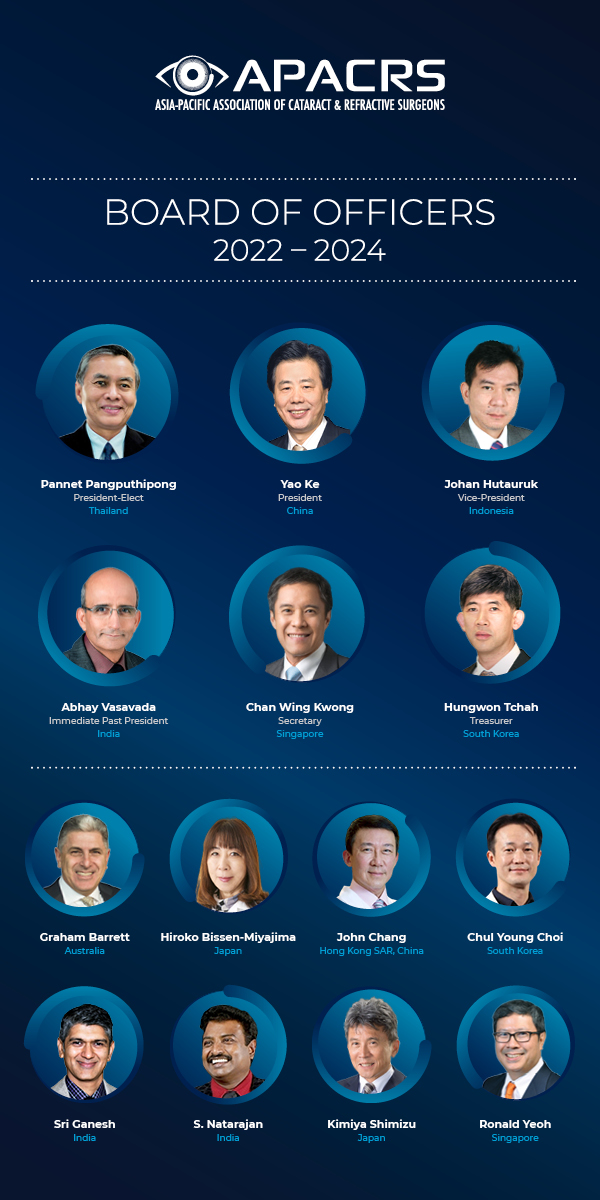
 EyeSustain Update
EyeSustain Update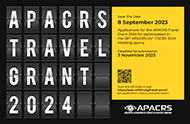 2024 APACRS TRAVEL GRANT
2024 APACRS TRAVEL GRANT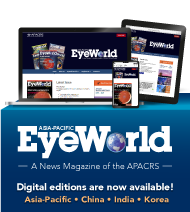 Digital EyeWorld
Digital EyeWorld VOL. 39 (2023), ISSUE 3
VOL. 39 (2023), ISSUE 3  Membership Information
Membership Information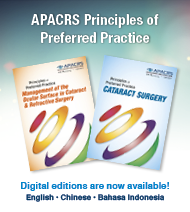 APACRS Principles of Preferred Practice
APACRS Principles of Preferred Practice